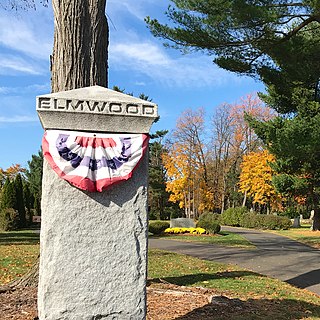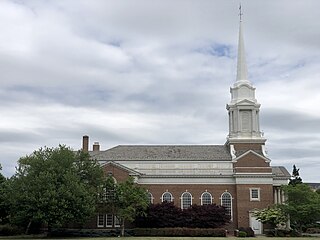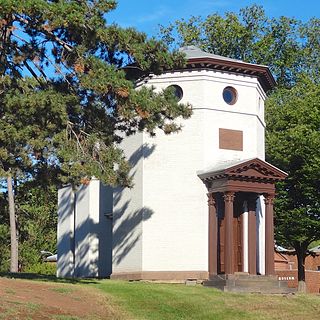
Rutgers University, officially Rutgers, The State University of New Jersey, is a public land-grant research university consisting of four campuses in New Jersey. Chartered in 1766, Rutgers was originally called Queen's College, and was affiliated with the Dutch Reformed Church. It is the eighth-oldest college in the United States, the second-oldest in New Jersey after Princeton University, and one of nine U.S. colonial colleges that were chartered before the American Revolution.

New Brunswick is a city in and the seat of government of Middlesex County, in the U.S. state of New Jersey. A regional commercial hub for central New Jersey, the city is both a college town and a commuter town for residents commuting to New York City within the New York metropolitan area. New Brunswick is on the Northeast Corridor rail line, 27 miles (43 km) southwest of Manhattan. The city is located on the southern banks of the Raritan River in the heart of the Raritan Valley region.

Henry Rutgers was a United States Revolutionary War hero and philanthropist from New York City. Rutgers University was named after him, and he donated a bond which placed the college on sound financial footing. He also gave a bell that is still in use.

New Brunswick Theological Seminary is a Reformed Christian seminary with its main campus in New Brunswick, New Jersey. It was founded in 1784 and is one of the oldest seminaries in the United States. It is a seminary of the Reformed Church in America (RCA), a mainline Reformed Protestant denomination in Canada and the United States that follows the theological tradition and Christian practice of John Calvin. First established in New York City under the leadership of the Rev. John Henry Livingston, who instructed aspiring ministers in his home, the seminary established its presence in New Brunswick in 1810. Although a separate institution, the seminary's early development in New Brunswick was closely connected with that of Rutgers University before establishing its own campus in the city in 1856.

The School of Environmental and Biological Sciences (SEBS) is a constituent school of Rutgers University's New Brunswick-Piscataway campus. Formerly known as Cook College—which was named for George Hammell Cook, a professor at Rutgers in the 19th Century—it was founded as the Rutgers Scientific School and later College of Agriculture after Rutgers was named New Jersey's land-grant college under the Morrill Act of 1862. Today, unlike the other arts and sciences schools at Rutgers, the School of Environmental and Biological Sciences specializes in environmental science, animal science and other life sciences. Although physically attached to the New Brunswick-Piscataway campus, most of the SEBS campus lies in North Brunswick, New Jersey.
Douglass Residential College is a non-degree-granting program established in 2007 and open to female undergraduate students at any of the degree-granting schools of Rutgers University-New Brunswick. It replaced the liberal arts degree-granting Douglass College which had been opened in 1918. Douglass, originally named New Jersey College for Women, was renamed in 1955 after its founder and first dean, Mabel Smith Douglass.

The Elmwood Cemetery is located at 425 Georges Road in North Brunswick, Middlesex County, New Jersey. It borders New Brunswick, New Jersey. The cemetery was established in 1868.

Old Queens is the oldest extant building at Rutgers University and is the symbolic heart of the university's campus in New Brunswick in Middlesex County, New Jersey in the United States. Rutgers, the eighth-oldest college in the United States, was founded in 1766 during the American colonial period as Queen's College. Queen's College was named for Charlotte of Mecklenburg-Strelitz, the daughter of a German duke who became the queen consort of British king George III. Old Queens is located on a six-acre hilltop city block bounded by Somerset Street, Hamilton Street, College Avenue and George Street that was previously an apple orchard. Donated to the college in 1807 by James Parker, Jr., this city block become known the Queen's Campus and is the historic core of the university. Because of this, by metonymy, the name "Old Queens" came to be used as a reference to Rutgers College and is often invoked as an allusive reference to the university or to its administration.
Rutgers University is an institution of higher learning with campuses across the State of New Jersey its main flagship campus in New Brunswick and Piscataway, and two other campuses in the cities of Newark and Camden, New Jersey.

The Eagleton Institute of Politics at Rutgers University was established in 1956 with an endowment from Florence Peshine Eagleton (1870–1953), and it focuses on state and national politics through education and public service. Ruth Mandel served as director for over 20 years, before being succeeded in that role by John Farmer Jr. in September, 2019, and Elizabeth C. Matto in September, 2022.

Rutgers University–New Brunswick is one of three regional campuses of Rutgers University, a public land-grant research university consisting of four campuses in New Jersey. It is located in New Brunswick and Piscataway. It is the oldest campus of the university, the others being in Camden and Newark. The campus is composed of several smaller campuses that are large distances away from each other: College Avenue, Busch, Livingston,Cook, and Douglass, the latter two sometimes referred to as "Cook/Douglass", as they are adjacent to each other. All 4 subcampuses connect primarily via State Route 18. Rutgers–New Brunswick also includes several buildings in downtown New Brunswick. It is classified among "R1: Doctoral Universities – Very high research activity". The New Brunswick campuses include 19 undergraduate, graduate, and professional schools. The New Brunswick campus is also known as the birthplace of college football.

The Sophia Astley Kirkpatrick Memorial Chapel, known as Kirkpatrick Chapel, is the chapel to Rutgers, The State University of New Jersey and located on the university's main campus in New Brunswick, New Jersey in the United States. Kirkpatrick Chapel is among the university's oldest extant buildings, and one of six buildings located on a historic section of the university's College Avenue Campus in New Brunswick known as the Queens Campus. Built in 1872 when Rutgers was a small, private liberal arts college, the chapel was designed by architect Henry Janeway Hardenbergh at the beginning of his career. Hardenbergh, a native of New Brunswick, was the great-great-grandson of Rutgers' first president, the Rev. Jacob Rutsen Hardenbergh. It was the third of three projects that Hardenbergh designed for the college.

Voorhees Chapel is one of two chapels on the campus of Rutgers, The State University of New Jersey in New Brunswick, New Jersey. Built in 1925 with a donation from Elizabeth Rodman Voorhees, wife of Rutgers trustee Ralph Voorhees, the chapel once served the community of Douglass College. Douglass, founded the New Jersey College for Women, was the women's residential college at Rutgers.

Geology Hall is a historic building on the Queens Campus of Rutgers University, in New Brunswick, New Jersey. It was built from April 1871 to June 1872 to house various science classes and the Rutgers Geology Museum. The museum was established in 1872 by George Hammell Cook, Rutgers' then professor of geology, with a collection of specimens whose assembly began in the 1830s under Cook's predecessor, Lewis Caleb Beck. As classes and offices moved out of the hall, the museum expanded until it occupied the entire hall by the mid-20th century. In 1973, the hall was added to the New Jersey and National Register of Historic Places (NRHP) with Old Queens, President's House, Van Nest Hall, Daniel S. Schanck Observatory, the Kirkpatrick Chapel, and Winants Hall as part of the Old Queens Campus historic district.

Alexander Johnston Hall is a historic building located on the corner of Somerset Street and College Avenue, New Brunswick in Middlesex County, New Jersey and is the second oldest building on the campus of Rutgers University. It was built in 1830 to handle the expansion of the Rutgers Preparatory School and the two literary societies, Philoclean and Peithessophian. The building, described using its historic name, Rutgers Preparatory School, was added to the National Register of Historic Places on July 18, 1975 for its significance in architecture and education.

The Daniel S. Schanck Observatory is an historical astronomical observatory on the Queens Campus of Rutgers University in New Brunswick, New Jersey, United States, and is tied for the seventh oldest observatory in the US alongside the Vassar College Observatory. It is located on George Street near the corner with Hamilton Street, opposite the parking lot adjacent to Kirkpatrick Chapel, and to the northeast of Old Queens and Geology Hall.

The Queens Campus or Old Queens Campus is a historic section of the College Avenue Campus of Rutgers, The State University of New Jersey in New Brunswick, New Jersey, in the United States.

Winants Hall is a historic educational building located on the Queens Campus of Rutgers University in New Brunswick, New Jersey. Designed by Van Campen Taylor and completed in 1890, Winants Hall is the oldest dormitory building at Rutgers University, known then as Rutgers College. The building was a gift to the university from Board of Trustees member and Bayonne businessman, Garrett E. Winants, and cost $75,000. The construction of the dormitory satisfied many long-awaited needs of the college. The new residential system also fostered a thriving social atmosphere for students, staff, and guests as it served as a student dormitory from 1890 to 1947.

New Jersey Hall is a historic education building located on the campus of Rutgers University in New Brunswick, New Jersey. Built in 1889 under the leadership of President Merrill Edward Gates, it housed the Agricultural Experiment Station. It was added to the National Register of Historic Places on February 24, 1975, for its significance in agriculture and education.

Wood Lawn is a historic mansion located off Ryders Lane on the Douglass Campus of Rutgers University in the city of New Brunswick in Middlesex County, New Jersey. The house was added to the National Register of Historic Places on March 8, 1978, for its significance in architecture and education. It is currently used by the Eagleton Institute of Politics.





















